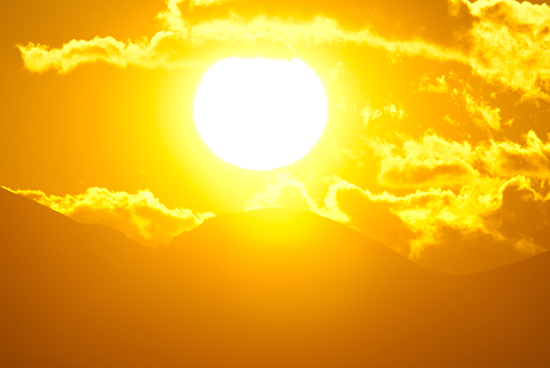
Save us from rising heat, say rallying food workers in B.C.
By Brishti Basu, Local Journalism Initiative Reporter, The Tyee

Photo: UMB-O/Adobe Stock
Summer is typically when restaurants hire and train new workers. During the 2021 heat dome, that meant few breaks for Khushi Mehta and her co-workers at a Vancouver pizzeria.
“We couldn’t really leave new employees on the line by themselves to take a break,” Mehta said, describing a hot, stuffy workplace with a large pizza oven and little ventilation.
“I don’t think there was a lot of emphasis put on physical well-being during our time working in those really high temperatures.”
Mehta quit working in the food service sector a few months after her experience in the heat dome and has since collaborated on projects with Workers Solidarity Network — a coalition of non-unionized and precarious workers in B.C. — to find ways that workplace safety could be prioritized during future extreme weather events.
WSN is asking the province to implement a maximum temperature limit for safe indoor work, particularly for food service workers, ahead of an expected hot, dry summer.
The group plans to rally outside Health Minister Adrian Dix’s Vancouver office on Friday afternoon to call for either new legislation or changes to existing rules that would implement a maximum temperature that’s safe for people to work indoors, according to Jen Kostuchuk, the climate and labour project co-ordinator at WSN.
Provincially set standards are important for non-unionized food service workers who are often vulnerable to losing paid work if they ask for accommodations, Kostuchuk said.
“For food service workers, refusing unsafe work is very complicated for many of them, when their hours and their wages are on the line or they fear broader employer retaliation,” said Kostuchuk, who herself worked in the food service industry on and off for 10 years.
“Other jurisdictions like Germany and Spain, for example, have set indoor limits for workplaces at 27 C, and they’ve also implemented mandatory cooling measures like misters and enforced breaks if temperatures exceed 35 degrees, especially in spaces with hot ovens.”
More ideas for improvement
Kostuchuk said the group is also calling for standards like workers being allowed frequent breaks for water and rest during heat waves, and leniency on dress codes that otherwise often require long black pants and long sleeve shirts even during the heat.
According to Kostuchuk, WSN and its members have sent 185 letters to ministers Adrian Dix, Harry Bains, Bowinn Ma and Premier David Eby on this subject and have yet to hear back.
Bains responded to questions sent directly from The Tyee on behalf of the Labour Ministry. “Our ministry and WorkSafeBC take workplace risks of any nature very seriously,” said Bains. “Last year the province introduced the BC Heat Alert and Response system. We welcome input — and we will continue to take action to protect workers in the face of our changing climate.”
Currently in B.C., workplace regulations are based on taking enough steps to make sure an employee’s core body temperature does not exceed 38 C. Federal occupational health and safety standards suggest a minimum of 18 C and a maximum of 29 C in food preparation areas.
Mehta said her project with WSN came up with a number of ideas for how to improve workplace conditions during heat waves: having a temperature gauge in the restaurant to indicate when it gets too hot to work, and employees being given paid time off in lieu of working during a heat wave are high on the list.
Last year WSN released a report that highlighted food service workers’ experiences during the 2021 heat dome and wildfire season that killed 619 people.
Stories of fainting on the job
In 2021, WorkSafeBC received 115 heat stress claims — nearly triple the average number of claims between 2018 and 2020 — and 81 claims in 2022. In a statement to The Tyee, WorkSafeBC said that number dropped down to 49 last summer.
“The past few summers haven’t been as extreme as 2021… but I’m hoping that this summer if there is a heat wave, government does push for restaurants not being open” during the high temperatures, Mehta said.
As a student who moved to Vancouver from India — where restaurants often shut down during the heat of the afternoon and stay open later during cooler, evening hours — Mehta said, “back home we’re more prepared for extreme weather than Vancouver as a whole is.”
“In our project we heard from workers who don’t have air conditioning in their workplace, and others who fainted on shift due to heat stress,” Kostuchuk said.
“[People] working in fast food drive-through windows described to us how extreme heat and wildfire smoke has presented adverse physical health impacts for them as well.”
Warmer than usual early spring weather has already broken dozens of temperature records across B.C. as of last weekend.
The upcoming summer season is expected to be a dry one, with snowpack levels across B.C. at nearly 40 per cent below normal this past winter. As a result, B.C. is preparing for an early wildfire season this year and Vancouver Coastal Health’s chief medical health officer Dr. Patricia Daly has called extreme weather caused by climate change an “existential threat to our population.”
Not much has yet been said about preparations for the heat and protections for workers — whether they work indoors or outside in industries like construction and agriculture — or for people with disabilities who were demonstrably at higher risk during the 2021 heat dome.